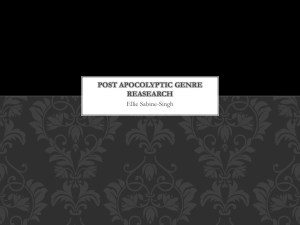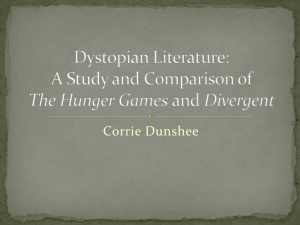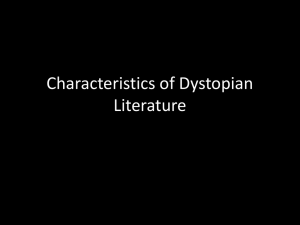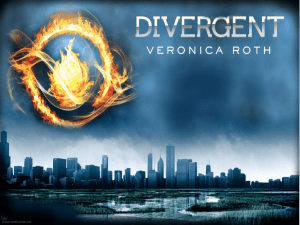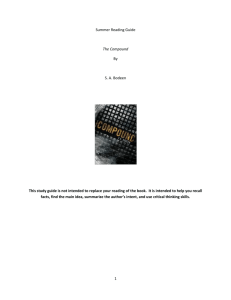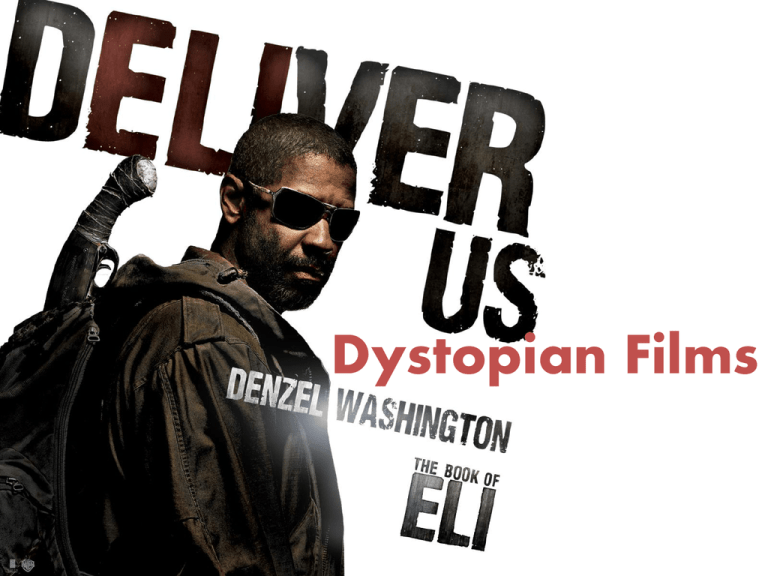
Dystopian Films
Narrative conventions of Dystopian
films
• The typical narrative themes for Dystopia film usually stems off a
disaster/war which changes the face of the world we know. Using real
time issues such as Global warming or Nuclear war as examples of how
films create an authenticity relating to fears in society today.
• Plot wise most Dystopian films are similar and conventional. Usually
stemming of the the idea of people struggling to survive or setting on a
path of finding tranquillity in harsh worlds. The films can also be set in the
future to show what society could be like. Often the characters are
searching for a sense of equilibrium which was present pre apocalypse but
it usually proves to be inevitable that the world they used to know is gone
for good.
• Examples of Dystopian films which follow the traditional conventions are :
The Road, Dawn of The dead, 28 weeks later.
Character Conventions
in Dystopian films
•
There is most often or not a male protagonist,
portrayed as a ‘post modern cowboy’. Who starts off
as a lone wolf type character but eventually is
forced into saving people from the fate of the new
world.
•
Groups/gangs form to survive/ to profit from violent
anarchy at the despise of others.
Cannibalistic/animalistic traits are common within
these groups.
•
The protagonist will find a group of survivors from
the pre apocalyptic world who will rely on him to
save them/ aid them. He will refuse to at first but his
morals are too strong to not help them in the end.
•
Once he helps the group of survivors(against the
gangs/tribes) he feels like he doesn’t belong in
either world and will end up striking out on his own.
Typical Camera Shots
• Typical camera shots used in Dystopian films can vary but mostly involve
the use of POV, long establishing shots, surveying pans.
• POV shots are often used from the point of view of a character known as
‘a carrier’ for example an infected human in 28 days later. It is used show
where the danger is coming, and implies a person in the film is about to
confront the ‘carrier’
• Long establishing shots, also common is Dystopian films. They can show
the audience a view of a particular landscape in the film. For example the
dystopian land of Mad Max, showing the wastelands in which the film is
set. Surveying pans are usually used within the establishing shots to show
a greater level of detail of the settings of the film.
Typical Editing Techniques
• Editing techniques are again quite varied, using a lot
of common techniques used in other genres of film.
• However I would say dissolves and fades are used
more than most. They can set the tempo of the film
and are a good technique to use for a change of
scene/ setting.
• Slow motion effects can be used in Dystopian films
in scenes of action or where the director feels the
scene is of importance. An example would be in The
Book of Eli in which the female character is being
attacked and is saved by Denzel Washington’s
character near the last minute
• Another effect which is used in The book of Eli is the
use of DE saturated/ Decoloured camera effects. Its
used emphasize the bleakness of the world the film
is set.
Narrative Conventions exhibited in The
Book of Eli
•
The film is set in a post apocalyptic world, presumably in America. The environment is
desolate and the population famished. The result of a Biblical war in which all but a few of
the St James Bibles were burned. In Dystopian films the environment is the most
noticeable change, as well as the depleted population of the human race.
•
Eli has one of the few remaining bibles and is told by god to go west to deliver it. Crossing
paths with gangs who want the bible for the purpose of wrong doing, using it to control
people. The Gang leader Carnegie, like Eli is one of the few people who were alive before
the devastation and so they have an understanding of what influence the book can have.
One of the conventions is that the Protagonist will cross paths with someone from the
past world, its interesting that in this case they are enemies.
Eli gains a companion in Solara, who tags along
after Eli’s failed attempts of ditching her. This is
a really typical element of the character/
Narrative in which most of the companions are
not wanted by the main protagonist but often
end up saving them in some form or another.
Character Conventions
exhibited in
The Book of Eli
Eli is a male protagonist, who falls
stereotypically into the long ranger persona.
His quest is to head ‘west’, guarding one of
the remaining bibles which survived the holy
war. He’s a man who is skilled at fighting,
though only attacks if he is the one being
attacked first – high moral mind set which is
also conventional.
•
•
Carnegie who is played by Gary Oldman is a kingpin who controls a gang of thieves
and thugs, who are actually looking for the Book which Eli has in his possession.
The gang is the obstacle Eli faces.
Solara is a young girl who Eli meets whilst stopping by in a town run by Carnegie’s
Mob/ Gang. Solara is offered as a means of sex to Eli in exchange for the Bible
which he carries. Eli turns down the offer and lets the girl share his food with him,
at first the girl is confused as to what is happening. Her generation are not used to
formalities such as eating a meal together. This highlights the typical character trait
of the hero who is stuck with the traditions of the pervious times and the girl who
has grown up knowing only the misery of the estranged society. Eli unwillingly
allows her to accompany him out of the town, she wants to escape the torment of
the gang.
Trailer analysis of the book of Eli
•
•
•
•
The trailer starts at a slow pace with the narrator from the
point of view of the main protagonist (Denzel Washington)
describing the state of the current dystopian world.
As the trailer builds it delves into fight
set pieces one after the after,
heightening the audiences excitement;
with cars blowing up and machetes
flying around.
As the violence dissipates the inter titles
of the a list cast appear on the black
screen to reinforce the audiences
anticipation and to further sell the film
to the spectator.
As a climax the title of the film then
appears for a few seconds before
another last piece of action of Denzel
Washington kicking down a door comes
to reinforce the audience pull.


